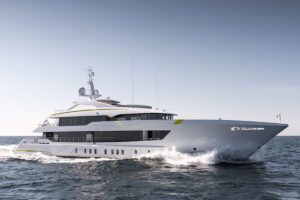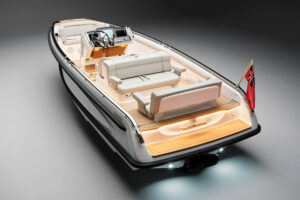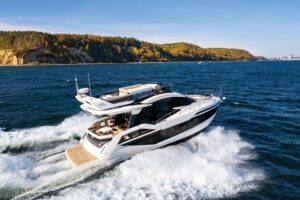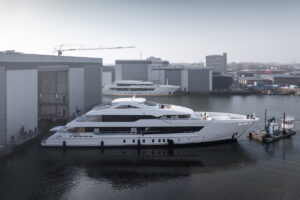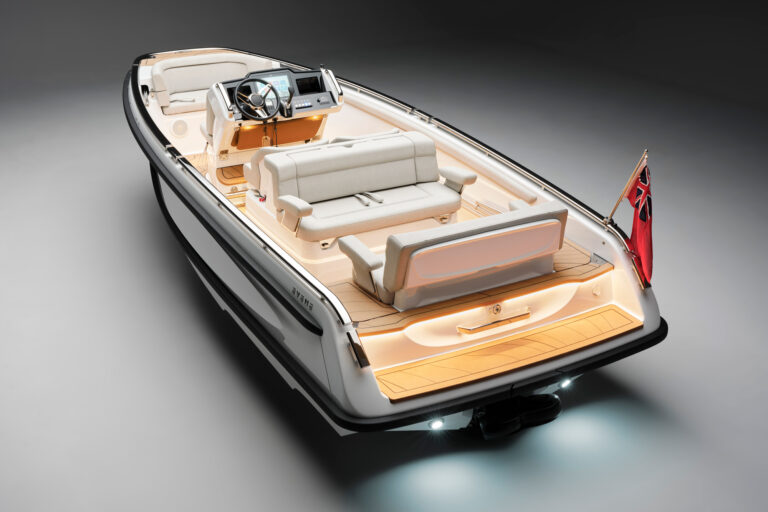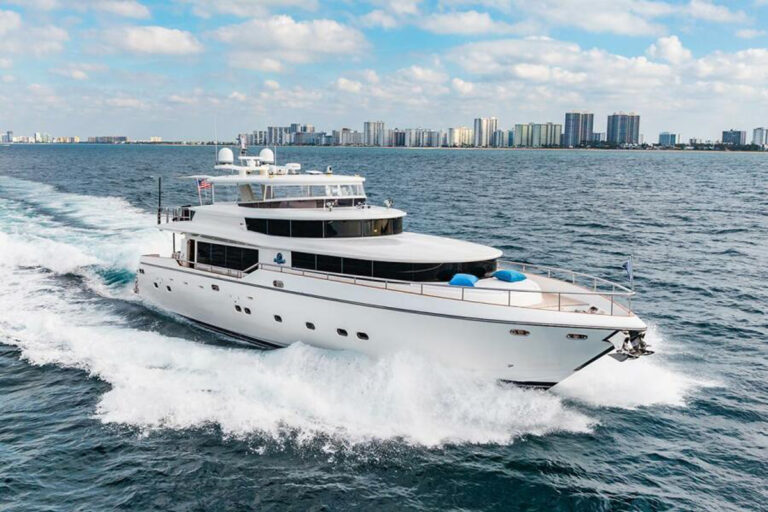Acadia, Acadia, Acadia-what a fine motoryacht you turned out to be, I thought as J.B. Turner, managing partner of Lyman-Morse, spun her like a top. Wind and a flooding tide threatened to send us headlong into the bridge that marks the limit of navigable water next to Lyman-Morse Boatbuilding in Thomaston, Maine. Turner shares management responsibilities with Cabot Lyman, whose family business joined with the Wilbur A. Morse yard (builder of Friendship Sloops when wood reigned) during the latter half of the 20th century to form the present company. The history of these families contains all that’s good about boatbuilding in Maine.
Acadia also contains all that’s good about boatbuilding in Maine. Setzer Design Group drew her to be fast for her type, agile, beautiful, comfortable and ever so endearing to anyone who experiences her personality. SDG and Lyman-Morse, which also collaborated on Magpie (“Body & Soul”, January 2002), have produced a nautical treasure.
Ward Setzer counts Acadia among his classic designs. She does not demand your attention with brash lines and visual tricks that wear thin soon after the launching party. Instead, she woos the observer with subtle details and the promise of an ever-deepening relationship-more Kristin Scott Thomas than Britney Spears. As good a designer as Setzer is, though, he can’t take all the credit for the aura Acadia carries with her or the ambience projected by her accommodations. The owner was intimately involved with the design and construction, so we’ll give our kudos to the designer/client relationship.
When we think about boats or attempt to describe a favorite design to a friend, we tend to separate the exterior styling from the arrangement plan. A thoughtfully conceived and sensitively designed yacht, however, marries the outside with the inside in such a way that having one without the other is impossible. Acadia is a perfect example. I see only two exterior styling elements that qualify as affectations: the subtle clipper bow and the swept windshield. Yes, the clipper bow is beautiful, and the yacht would suffer from its absence, but Acadia would function perfectly well without it. She would also lose most of her grace if we made the windshield vertical or raked it forward. On the other hand, we’d gain useful space in the pilothouse and would hardly need windshield wipers.
The instant I stepped from the cockpit into the saloon, the shape and height of the superstructure made sense. Morning sun washed over the satin-finished mahogany joinerwork, making me want to sit and sip coffee in idle conversation with my best mates, the vocal cotton candy of Norah Jones filling the short silences. Can anyone imagine such a scene playing behind scalpel-shape windows and darkened glass?
Simple fabrics and shapes encourage guests who enter the saloon to kick off their shoes-not because they fear scratching the varnish of the sole or soiling the carpet, but because they feel so at home. Though the relatively dark hue of the mahogany dominates the saloon, a savvy decorator could splash color here and there without interfering with the bold elements of the space. The white overhead, made of sheet plywood panels routed to resemble tongue-and-groove planking, reflects the ambient light, adding to the feeling of spaciousness. These panels nestle among varnished mahogany deck beams, recalling the interior treatments of the Herreshoff family’s era.
Space is what Acadia‘s saloon has in spades. The dining table seats eight, and everyone can ogle the scenery outside simply by lifting his eyes from his plate. Casual entertaining is easy thanks to the wide passageway into the pilothouse and the large portside pass-through bulkhead, which separates the galley and the saloon. While the cook performs culinary magic, he can still be within earshot of and make eye contact with guests in the saloon. After dinner is served, the pocket doors can be closed, creating a most enjoyable atmosphere at the table.
I loved the galley. All that natural light from the tall windshield and large, upright side windows prevents the galley slave of the day from catching a case of claustrophobia. It has space enough to provide all the appliances and immediately accessible stowage one needs, but its relatively tight U-shape makes the chef feel secure preparing meals while the boat is at sea.
The trunk cabin molded into the deck just forward of the superstructure gives the forward staterooms, heads and the utility room a generous amount of headroom, at the same time keeping the cabin soles from being pinched by the steep deadrise in the forward sections. The portside stateroom houses a pair of single berths divided by a night table and bookcase. When I was aboard Acadia, the shelves held all the ship’s manuals. This stateroom is a perfect spot for the crew.
A spacious and comfortable double stateroom occupies the forward portion of the yacht. It has an island berth, bookshelves flanking the carved headboard, and more stowage than I have clothing and other personal items to fill. A painting of an island seascape graces the bulkhead above the headboard. The white overhead combines with natural light from the big portlights and hatches to completely erase the dungeon-like feeling of such spaces I’ve seen aboard some yachts this size. As a VIP stateroom, it scores a nine. As a captain’s stateroom, it scores a 10.
The owner expects to spend a great deal of time aboard Acadia, and will begin an ambitious schedule of cruising this spring. His desire to make the yacht a home spawned a lot of her features. The utility room just forward of the galley on the port side is one of my favorites. There, I found a Maytag washer and dryer stacked neatly into a space just inside the entrance. A workbench, covered with stainless steel, fills the outboard space. Beneath it lives a lockable tool cabinet and stowage lockers for spare parts and other items devoted to maintaining a big yacht at sea, plus additional cubic feet of refrigerator and freezer. This room also provides access to the 4,000 pounds of house batteries (enough juice to run the lighting for 16 hours), two 30kW Kilo Pak generators, three chillers for the air-conditioning system, the 1,500-gallon-per-day watermaker and two 40-gallon water heaters. I was impressed, but even more so when I discovered the Mastervolt battery chargers, which bring the batteries to 80 percent of full charge within four hours. A pair of 5,000-watt DC converters completes Acadia‘s arsenal of self-sufficiency equipment.
Abaft the machinery space and beneath the saloon lies the owner’s stateroom. Oh, my. Pack my bags, Jeeves; we’re moving in. An extra-large double berth (commonly called a queen berth) forms an island on the centerline. Cabinets outboard of the berth would stow all of her majesty’s many changes of clothing and still have space left for a few shirts and sweaters belonging to the master. All kidding aside, I have to rate the stowage as bountiful. Large portlights on both sides and white ceilings and overheads ward off the gloom common in belowdecks staterooms.
Massive MTU 2000 Series diesels rumbling to life signaled the end of my fantasy tour. Time to see what Setzer had wrought. As we went from idle to full throttle, displacement to planing mode, it actually felt as though we were accelerating-as opposed to merely gathering speed. That alone was impressive, but it was nowhere near as startling as Acadia‘s maneuverability at speed. A sea of lobsterpot buoys created a super-challenging slalom run down the St. George’s River. Acadia‘s quick Hynautic power steering and instantaneous response let us carve our way as though we were driving a 25-foot ski boat. We have big rudders and a carefully drawn bottom to thank for this handling.
The view from the flying bridge is excellent in all directions. Since the bridge is sure to be a gathering spot during fine weather, it houses an icemaker, a refrigerator, a sink and stowage for utensils. An L-shape settee encourages lounging under the hardtop.
Back at the dock, I hated to bid farewell to this friendly yacht. I hope we meet again one day, and that she’ll have a berth for one more member of the crew.
Contact: Lyman-Morse Boatbuilding, (207) 354-6904; www.lymanmorse.com. For more information, contact: (866) 922-4877; www.yachtingnet.com/yachting/productinfo.

